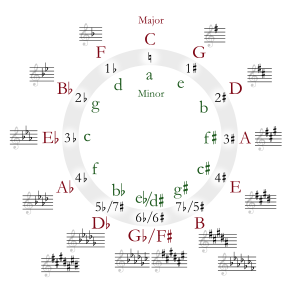- D-flat major
-
D♭ major 
Relative key B♭ minor
enharmonic: A♯ minorParallel key D♭ minor
enharmonic: C♯ minorEnharmonic C♯ major Component pitches D♭, E♭, F, G♭, A♭, B♭, C, D♭ D-flat major is a major scale based on D-flat, consisting of the pitches D♭, E♭, F, G♭, A♭, B♭ and C. Its key signature has five flats (see below: Scales and keys).
Its relative minor is B-flat minor. Its parallel minor is D-flat minor, usually replaced by C-sharp minor, since D-flat minor, which would contain a double-flat in the key signature, is rarely used for practical composing and arranging. Thus, in his Prelude No. 15 in D-flat major ("Raindrop"), Frédéric Chopin switches from D-flat major to C-sharp minor for the middle section in the parallel minor, while in his Fantaisie-Impromptu, primarily in C-sharp minor, he switches to D-flat major for the middle section for the same reason.
D-flat major is enharmonic to C-sharp major. In music for the harp, D-flat major would be preferable, not only for the reason that harp strings are more resonant in the flat position, but also because modulation to the dominant key is easier (by putting the G pedal in the natural position, whereas there is no double-sharp position in which to put the F pedal for G-sharp major).
Hector Berlioz called this key "majestic" in his 1856 Grand Traité d'Instrumentation et d'Orchestration modernes, while having a much different opinion of its enharmonic counterpart. Despite this, when he came to orchestrate Carl Maria von Weber's piano piece Invitation to the Dance in 1841, he transposed it from D-flat to D major, to give the strings a more manageable key and to produce a brighter sound.[1]
Charles-Marie Widor considered D-flat major to be the best key for flute music.[2]
Although this key was relatively unexplored during the Baroque and Classical periods, Franz Schubert used it quite frequently in his sets of écossaises, valses and so on, as well as entering it and even flatter keys in his sonatas, impromptus and the like. Beethoven, too, used this key extensively in his Second Piano Concerto.
The flatted pitches of D-flat major correspond to the black keys of the piano, and there is much significant piano music written in this key. Pyotr Ilyich Tchaikovsky's Piano Concerto No. 1 is written in B-flat minor, but the famous opening theme is in D-flat major. Sergei Rachmaninoff composed the famous 18th variation of his Rhapsody on a Theme of Paganini in this key. Claude Debussy also composed the famous Clair de lune in this key, with a significant section in C-sharp minor. Edvard Grieg composed the second movement of his Piano Concerto in D-flat. Frédéric Chopin's Nocturne in D-flat, Op. 27, is in this key.
In orchestral music the examples are fewer. Gustav Mahler concluded his last completed Ninth Symphony with an adagio in D-flat major, rather than the home key of D major of the first movement. Antonín Dvořák wrote the second movement of his Symphony No. 9 in D-flat major. Every other movement is in E minor. The first piano concerto of Sergei Prokofiev is also written in D-flat major, with a short slow movement in G-sharp minor.
Jazz music has many songs in D flat, most of them with a piano in them, e.g. Nat Cole, Fats Domino, etc. This is probably because of the mode of playing with more of the black keys, where many jazz songs use the pentatonic black key scale F♯ major or E♭ minor. Also it could be due to the fondness of brass and woodwind instruments for playing in flat keys. Probably the easiest major key for many of these instruments is B♭, followed by E♭, A♭, and then D♭. The concert pitch key of C would have two sharps for one of these brass instruments, whereas D♭ would have three flats, based in the concert pitch of E♭, since the B♭ instruments play a whole step higher than concert pitch when reading music, i.e., musical passage with no sharps or flats would be the B♭ major scale for these brass instruments. D♭ might be a good key in the range of E♭, but a little be lower for singing more in the range of the key of C, yet higher than B♭. In contrast to piano and horns, the guitar and bass instruments tend to stick to the keys of E, A, D, G, and D, and also C, all of which utilize many open unfretted strings. However, a capo can be employed on these instruments to move the keys up or down, not unlike using the "transpose" button on a digital keyboard which can change the key to any key you like, all the while playing in your favourite set of keys, say the white keys, which would otherwise make up the C major scale.
References
- ^ The Hector Berlioz Website
- ^ Charles-Marie Widor, Manual of Practical Instrumentation translated by Edward Suddard, Revised Edition. London: Joseph Williams, Ltd. (1946) Reprinted Mineola, New York: Dover (2005): 11. "No key suits it [the flute] better than D♭ [major]."
Scales and keys
Diatonic scales and keys Flats Sharps Major minor Major minor 0 C a C a 1 F d G e 2 B♭ g D b 3 E♭ c A f♯ 4 A♭ f E c♯ 5 D♭ b♭ B g♯ 6 G♭ e♭ F♯ d♯ 7 C♭ a♭ C♯ a♯ 8 F♭ d♭ G♯ e♯ The table indicates the number of sharps or flats in each scale. Minor scales are written in lower case. Categories:- Musical keys
- Major scales
Wikimedia Foundation. 2010.

